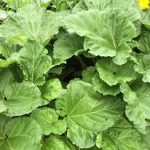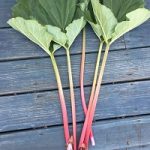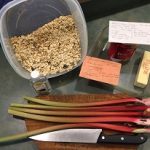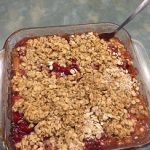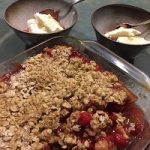About seven years ago we moved from a small house near downtown to Winding Pathways. We looked forward to our new home but didn’t want to leave some plants we’d cared for in the former yard. One was rhubarb. Fortunately, our move happened in early spring, so we were able to dig up dormant roots and plant them in our new yard. Now, they are thriving.
Rhubarb grows wild in parts of China but was domesticated centuries ago. It has been a valued garden and yard plant in temperate climates ever since. It is vigorous, attractive, and makes delicious food. Because it’s a perennial, it never needs replanting and pops out of the ground like magic each spring.
The plant thrives in rich soil and full sun but isn’t fussy. As long as it gets some daily sunshine and moisture, rhubarb grows well nearly everywhere. Few pests bother it, although deer eat the leaves in late summer or fall. Deer somehow resist toxins in rhubarb leaves that can sicken people. Fortunately, the stalks are delicious and nonpoisonous to humans.
Rhubarb is useful in landscaping and delicious in recipes.
We planted ours along a fence where it softens the straight line while giving us many pickings for the kitchen. We’ve never had rhubarb spread to places where we don’t want it. It is well behaved. Plant it where you want it and it likely will stay there.
When summer warmth arrives clumps of rhubarb often sent up a flower stalk. We pull out the flowering stalk, but other than that, the plants need little work. We are careful not to overharvest the stalks and give them plenty of time to regrow. Occasionally we do lightly harvest in summers of abundant rain and heat and enjoy recipes that include our own cherries and eggs from our chickens.
We prepare rhubarb one of several ways. The easy way is by pulling out a dozen, or so, stalks, adding the chopped off leaves to the compost bin, rinsing the stalks and cutting them into 1” chunks. We add sugar or honey to a pot full of stalk chunks and boil for about ten minutes with an occasional stirring. The resulting sauce is delicious on ice cream or pancakes or with plain yogurt. It’s good when added to oatmeal or just eaten as is. Rhubarb is tart and meshes well with ultra-sweet mulberries that ripen in late spring or nearly any other sweet fruit.
Two of our favorite pie and crunch recipes are Davenport Deluxe Pie by Joan Auterman and Rhubarb-Cherry Crunch from Clara Brown a long-ago friend from New England and Florida, Clara and Leon Brown were surrogate grandparents to a dear friend, Kathy Wentworth Taylor formerly of England. We love these best when all the major ingredients come from our garden, fruit trees and chickens.
Davenport Deluxe Pie
Preheat oven to 425°
1 large pie shell
3 cups chopped rhubarb in large bowl
Topping: ¼ cup flour, ¼ cup oatmeal, ¼ cup brown sugar, ¼ teaspoon each of baking powder and soda. ½ cup butter. Cut the butter into the above mixed ingredients. Set aside.
Mix: 2 cups sugar, 5 Tablespoons flour, 3 beaten eggs and stir in rhubarb. Add to pie shell.
Add topping. Bake 25 minutes at 425° and then 30 minutes at 350°
Cool before serving with rich vanilla ice cream.
Clara’s Rhubarb-Cherry Crunch
Preheat oven to 350°
Filling: Combine in a sauce pan and boil to thickness: 1 cup sugar, 1 cup water, 2 Tablespoons cornstarch. Add cherry pie filling. (if using real sour cherries drain well first so the acid does not thin the syrup.) Turn off heat and add 1 teaspoon almond flavor.
Bottom and crust: mix together 1 cup each of oatmeal, brown sugar and flour. Cut in ½ cup butter until pea sized mixture. Lightly grease bottom and sides of pan. Press ½ of this mixture on bottom of a pan.
Add rhubarb on top of the bottom crust. Add the boiled cherry pie filling. Top with remainder of crust. Bake at 350° for 45 minutes. Cool slightly and serve with rich vanilla ice cream.
- Rhubarb with leaves
- Key ingredients for crunch
- Crunch ready to serve
- Mmmmmm! Warm with ice cream

